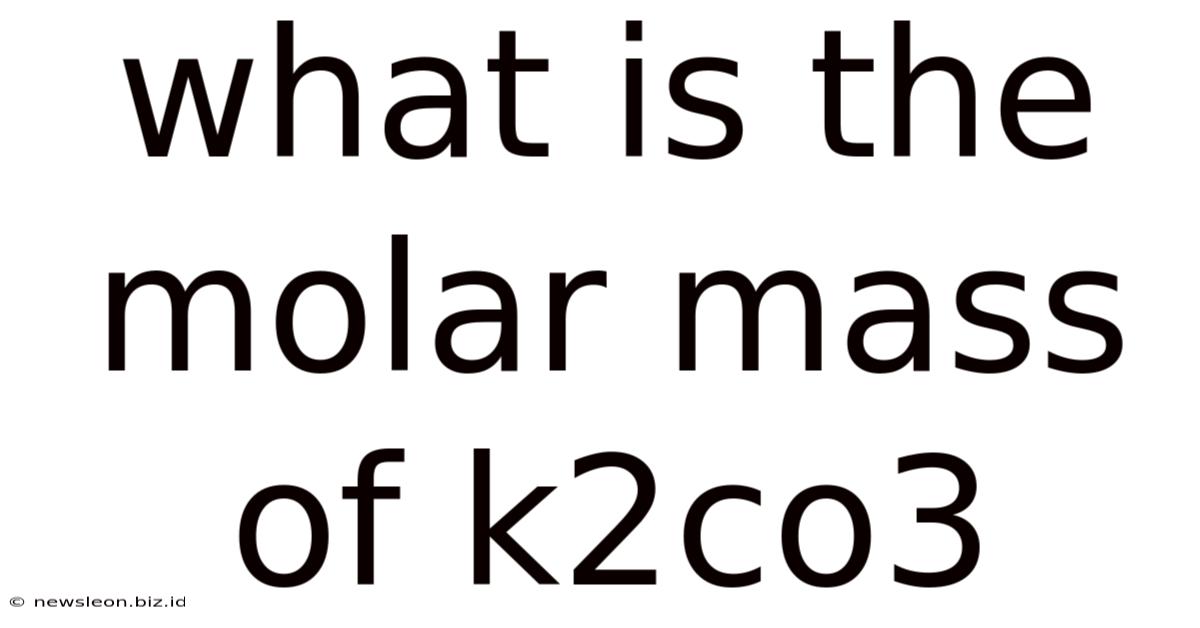What Is The Molar Mass Of K2co3
News Leon
Mar 24, 2025 · 5 min read

Table of Contents
What is the Molar Mass of K₂CO₃? A Comprehensive Guide
Potassium carbonate (K₂CO₃), a white, crystalline salt, finds widespread use in various industries, from glassmaking to food production. Understanding its molar mass is fundamental to numerous chemical calculations, from stoichiometry to solution preparation. This article delves deep into determining the molar mass of K₂CO₃, exploring the underlying concepts and practical applications.
Understanding Molar Mass
Before calculating the molar mass of K₂CO₃, let's clarify the concept. Molar mass is the mass of one mole of a substance. A mole is a fundamental unit in chemistry representing Avogadro's number (approximately 6.022 x 10²³) of particles (atoms, molecules, ions, etc.). The molar mass is expressed in grams per mole (g/mol).
It's crucial to differentiate molar mass from molecular weight. While often used interchangeably, molecular weight refers to the mass of a single molecule, typically expressed in atomic mass units (amu). Molar mass, however, represents the mass of a mole of molecules, making it directly applicable to real-world laboratory measurements and calculations.
Calculating the Molar Mass of K₂CO₃
To calculate the molar mass of K₂CO₃, we need the atomic masses of its constituent elements: potassium (K), carbon (C), and oxygen (O). These values are typically found on the periodic table:
- Potassium (K): Approximately 39.10 g/mol
- Carbon (C): Approximately 12.01 g/mol
- Oxygen (O): Approximately 16.00 g/mol
The chemical formula K₂CO₃ indicates that one molecule of potassium carbonate contains:
- Two potassium atoms (2K)
- One carbon atom (1C)
- Three oxygen atoms (3O)
Therefore, to calculate the molar mass, we sum the atomic masses of each element, multiplied by its respective quantity in the molecule:
(2 x Atomic mass of K) + (1 x Atomic mass of C) + (3 x Atomic mass of O)
Substituting the values from the periodic table:
(2 x 39.10 g/mol) + (1 x 12.01 g/mol) + (3 x 16.00 g/mol)
This simplifies to:
78.20 g/mol + 12.01 g/mol + 48.00 g/mol = 138.21 g/mol
Therefore, the molar mass of K₂CO₃ is approximately 138.21 g/mol.
Significance of Molar Mass in Chemical Calculations
The molar mass of K₂CO₃ is a crucial piece of information in various chemical calculations. Here are some examples:
1. Stoichiometry
Stoichiometry involves calculating the quantities of reactants and products in a chemical reaction. Knowing the molar mass of K₂CO₃ allows us to convert between mass and moles, enabling accurate stoichiometric calculations. For instance, if we know the mass of K₂CO₃ used in a reaction, we can determine the number of moles involved using the following formula:
Moles = Mass (g) / Molar Mass (g/mol)
2. Solution Preparation
Molar mass is essential for preparing solutions of a specific concentration. For example, to prepare a 1 Molar (1M) solution of K₂CO₃, we need to dissolve 138.21 grams of K₂CO₃ in enough solvent to make one liter of solution. The molar mass ensures we use the correct amount of solute to achieve the desired concentration.
3. Determining Empirical and Molecular Formulas
In analytical chemistry, molar mass is used to determine the empirical and molecular formulas of unknown compounds. By knowing the molar mass and the percentage composition of elements, the empirical formula can be determined. If the molecular weight is also known, the molecular formula can be found.
4. Titration Calculations
In acid-base titrations, where K₂CO₃ might be used as a titrant or analyte, the molar mass is necessary for accurate calculation of the concentration of the unknown solution.
Practical Applications of Potassium Carbonate
The versatility of K₂CO₃ is reflected in its diverse applications:
1. Glassmaking
K₂CO₃ is a crucial ingredient in the production of glass. It acts as a flux, lowering the melting point of silica and facilitating the formation of glass.
2. Food Industry
In the food industry, potassium carbonate acts as a raising agent, providing a similar function to baking soda. It's also used as a pH control agent and in the processing of cocoa.
3. Fertilizers
Due to its potassium content, K₂CO₃ finds application in fertilizers, providing a vital nutrient for plant growth.
4. Fire Extinguishers
Certain types of fire extinguishers utilize potassium carbonate as a dry chemical extinguishing agent.
5. Chemical Synthesis
K₂CO₃ is a common reagent in organic chemistry, employed in reactions such as alkylations and transesterifications.
Error Analysis in Molar Mass Calculation
It's important to acknowledge potential sources of error in the molar mass calculation. These primarily stem from the values of atomic masses used. The atomic masses presented in the periodic table are weighted averages, accounting for the isotopic abundances of each element. Slight variations in these values can lead to minor differences in the calculated molar mass. However, these variations are typically negligible for most practical applications.
Furthermore, the accuracy of the calculated molar mass depends on the precision of the measuring instruments used in any experimental determination of the mass or quantity of K₂CO₃. Accurate weighing of samples is crucial for precise calculations.
Conclusion
The molar mass of K₂CO₃ is a cornerstone value in understanding and working with this versatile compound. Its precise determination (approximately 138.21 g/mol) is crucial for various chemical calculations, ranging from stoichiometry and solution preparation to analytical chemistry applications. Understanding its significance within the broader context of chemical principles and its myriad practical applications enhances its importance in various scientific and industrial fields. Always remember to use the most accurate atomic masses available for the most precise calculation. Careful consideration of potential sources of error, including the precision of measurements, is also vital for achieving accurate results.
Latest Posts
Related Post
Thank you for visiting our website which covers about What Is The Molar Mass Of K2co3 . We hope the information provided has been useful to you. Feel free to contact us if you have any questions or need further assistance. See you next time and don't miss to bookmark.